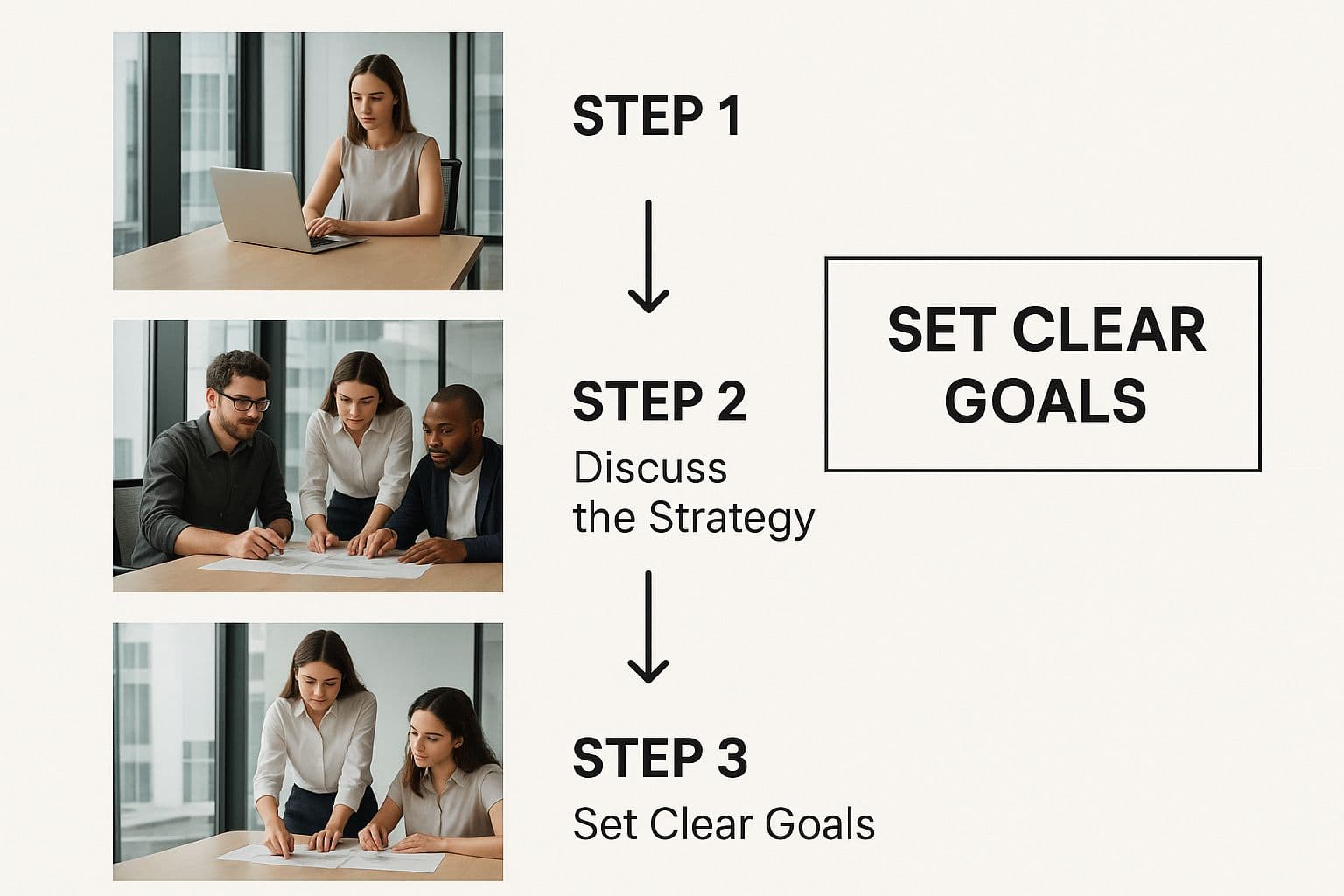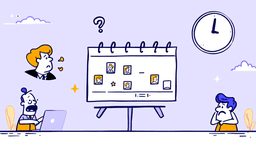Let's be real—most people would rather do anything than sit through another meeting. They often feel like a black hole for productivity, where conversations go in circles and nobody leaves knowing what to do next. If your team walks out of a meeting feeling drained and confused, you're not alone.
This isn't just a feeling; it's a huge drain on company resources. Unfocused meetings carry a real cost, both in wasted hours and in deflated team morale. When discussions don't have a clear purpose, you're squandering your most valuable assets: your team's time and energy. This is exactly why learning how to run a great team meeting isn't just a "nice-to-have" skill—it's a business necessity.
Why Your Team Meetings Are Failing
The financial and cultural fallout from bad meetings is massive. It’s easy to think of an hour-long meeting as just 60 minutes, but multiply that by every single person in the room, and the cost balloons. Beyond the money, it kills momentum and erodes the trust your team has in leadership.
The Hidden Costs of Bad Meetings
A huge part of the problem is just the sheer number of meetings we attend. Research shows that a staggering 78% of professionals point to too many meetings as the main reason they're unproductive. This adds up to a global loss of about 24 billion hours every single year.
A major culprit? A simple lack of planning. Only 37% of meetings worldwide begin with a set agenda, a tool that 61% of C-suite executives believe is absolutely critical for success. You can dig into more data on meeting productivity from Rev.com.
To fix this, we need to get to the root of the problem. Turning a failing meeting culture around comes down to a few core principles that separate the productive sessions from the time-wasters.
The Anatomy of a High-Impact Meeting
Here's a quick look at the core principles that separate productive meetings from time-wasting ones.
| Principle | What It Looks Like in Practice | Why It Matters |
|---|---|---|
| Intentional Preparation | Defining one clear purpose, creating an outcome-focused agenda, and inviting only essential people. | Sets the foundation for a focused conversation and respects everyone's time. |
| Dynamic Facilitation | Keeping the conversation on track, encouraging balanced participation, and guiding the group toward clear decisions. | Prevents conversations from derailing and ensures all voices are heard, leading to better outcomes. |
| Decisive Follow-Through | Summarizing decisions, assigning clear action items with owners and deadlines, and ensuring accountability. | Turns discussion into action and builds momentum that carries forward long after the meeting ends. |
Building a habit around these three pillars—preparation, facilitation, and follow-through—is what transforms meetings from something your team dreads into something that actually moves the needle.
Set Your Meetings Up for Success
A great meeting doesn't just happen when everyone logs on. It starts long before that, with smart, intentional preparation. I’ve seen it a hundred times: skipping this part is like trying to build furniture without the instructions. You'll get something done, but it’s rarely what you actually wanted.
The best meetings are the ones where people show up already on the same page, knowing exactly why they're there. This prep phase is your best shot at turning a potential time-waster into a genuinely productive session. It all boils down to one simple question: "What is the one thing we absolutely must decide or accomplish by the end of this?" If you can't answer that in a single, clear sentence, you probably don't need a meeting.
Figure Out the "Why" and the "Who"
Once you know your meeting's purpose, it becomes a filter for everything else—especially who gets an invite. A classic mistake is inviting half the company, which is a surefire way to kill focus and drag out decisions. You have to be ruthless with that attendee list.
For every single person you consider inviting, ask yourself if they are:
- A decision-maker who has the authority to give the final green light.
- An essential contributor whose knowledge is absolutely necessary for the conversation.
- Directly impacted by the outcome and needs to have a voice in the decision.
If someone doesn't fall into one of those buckets, just send them the meeting notes afterward. Seriously. Keeping the group small and focused is one of the most powerful things you can do.
This is the first, most crucial step in the whole process. Get the objective right, and everything else falls into place.

As you can see, a clear goal is the bedrock. From there, you can build the rest of your meeting, from the invite list to the agenda.
Write an Agenda That Actually Drives Action
Okay, you’ve got your purpose and your people. The last piece of the pre-meeting puzzle is an agenda that pushes for outcomes, not just endless talk. A good agenda isn't just a list of topics; it's a game plan.
It’s shocking how often this gets skipped. One study found that 64% of recurring meetings and 60% of one-off meetings happen without any agenda at all. That’s a massive waste of time and energy. It's also interesting that while most one-off meetings (90%) have six or fewer people, the recurring ones tend to get bloated, making them even more inefficient.
To avoid falling into that trap, build your agenda around three simple columns for each item:
| Topic | Time Allotted | Desired Outcome |
|---|---|---|
| Q1 Marketing Budget Review | 15 min | Final decision on budget for new campaign. |
| Project Phoenix Blockers | 20 min | Identify top 3 blockers and assign owners to fix them. |
| Next Steps & Action Items | 5 min | Confirm who is doing what and by when. |
This small shift turns the agenda from a passive piece of paper into a powerful tool. It sets clear expectations and keeps everyone pointed toward the finish line. If you need more ideas, we’ve put together a guide with some great effective meeting agenda examples.
Just be sure to send it out at least 24 hours ahead of time. It gives everyone a chance to show up ready to contribute from minute one.
Facilitate Meetings People Want to Attend

An agenda gives you a map, but great facilitation is how you actually navigate the terrain. When the meeting starts, your job shifts from planner to active guide. You’re there to steer the conversation, keep the energy up, and make sure the discussion is productive for everyone involved.
Without someone actively in the driver's seat, even a perfect agenda can fall apart. It’s on you to create a space where the team feels focused, respected, and genuinely empowered to share their best ideas. Mastering this is at the heart of learning how to run effective team meetings.
Keep the Conversation on Track
We've all been there. A meeting gets derailed by a fascinating but totally irrelevant tangent that eats up precious time. As the facilitator, your job is to gently but firmly bring everyone back to the agenda without making anyone feel shut down.
One of the most effective tools for this is the "parking lot." It’s a simple but brilliant concept. When a good but off-topic idea pops up, you acknowledge its value and jot it down in a designated space—a whiteboard, a flip chart, or a shared doc.
You can say something like, "That's a fantastic point, Alex. It definitely deserves a proper discussion. I'm adding it to our parking lot to make sure we tackle it after this meeting." This validates the person's contribution while protecting the meeting's focus.
Another key technique is timeboxing. Your agenda should already have time estimates for each item. Now, you have to be the timekeeper. Gentle reminders can work wonders to keep things moving:
- "We have about five minutes left on this topic. What's the one thing we need to decide right now?"
- "Great discussion, everyone. In the interest of time, let's shift to our next agenda item."
These techniques aren't about being rigid; they're about respecting everyone's time. A study from Atlassian found that employees consider meetings ineffective 72% of the time, often because they lack this kind of focused direction.
Encourage Balanced Participation
Every team has its mix of personalities. You'll have the outspoken members who are quick to share and the quieter thinkers who prefer to process before speaking. A great facilitator makes sure the loudest voices don't drown everyone else out.
Your role here is to intentionally create space for everyone to contribute. You can directly—and kindly—invite quieter members to share their thoughts. For example, "Sarah, you have a lot of experience in this area. What are your thoughts on this proposal?"
For those who tend to dominate the conversation, you can gently interject to open the floor to others. Acknowledge their point and then pivot: "Thanks, Mark, that's a helpful perspective. I'd love to hear what some others are thinking as well."
This isn't about silencing anyone; it's about finding equilibrium. When you actively manage participation, you tap into a much richer pool of ideas and end up making better, more well-rounded decisions. It’s how you turn a room of passive listeners into a truly collaborative team.
Turn Conversations Into Concrete Action
A meeting that doesn’t end with clear next steps is just an expensive conversation. The whole point of getting everyone in a room (virtual or otherwise) is to turn those discussions into tangible progress. This is where you convert all that talk into forward motion, but it won't happen by itself.
You have to have a plan for making decisions. Without one, you'll just talk in circles until the clock runs out. Think ahead: Is this a big decision that needs everyone's buy-in? Or can you just take a quick vote to keep things moving? Sometimes, a senior leader just needs to make the call. Knowing which approach to use before you hit the final minutes is key to avoiding a stall.
Assign Clear Action Items
Once you've made a decision, you need to break it down into actual tasks. Vague promises like "we'll look into that" are where good ideas go to die. For any meeting to be truly effective, every single action item needs to be captured with three essential details.
- A Single Owner: Assigning a task to a whole group means no one really owns it. It’s a classic case of diffused responsibility. Instead, give every single action item one person’s name. They are the one accountable for seeing it through.
- A Firm Deadline: "ASAP" isn't a deadline; it's a wish. Every task needs a specific due date. This creates a healthy sense of urgency and makes it possible to actually track progress.
- A Clear Definition of "Done": What does success for this task actually look like? Get specific. Don't just write "research new software." A much better action item is, "Compile a list of three potential software vendors with pricing and a feature comparison by this Friday."
Summarize and Align Before Adjourning
Never let people just drift away when the meeting is over. That last two to five minutes are gold. Use them for a quick, rapid-fire summary of what was decided and who’s doing what. This is absolutely non-negotiable.
Go down the list of action items one last time, calling out the owner and the deadline for each. It’s a simple step, but it’s your final chance to make sure everyone is on the same page and to catch any misunderstandings before they can cause problems later. This final check for alignment is a cornerstone of a well-run meeting. To see how this fits into a broader structure, you can find great examples in these top business meeting agenda example templates for 2025.
This one habit can transform a good chat into a powerful session that builds real, tangible momentum for your team.
Guarantee Progress with Effective Follow-Up
The buzz from a great meeting can fade fast. All that positive energy and all those brilliant ideas? They disappear the moment people walk out the door and forget what they agreed to do. Without a solid follow-up plan, even the most productive conversations become a distant memory, and projects stall out.
This is where you turn talk into action. It’s the single most important step in justifying the time everyone just spent together.

Think about it: the cost of bad meetings is staggering. In the U.S. alone, companies lose an estimated $37 billion every single year to unproductive get-togethers. When you learn that 71% of senior managers think most meetings are a waste of time, it's clear that a killer follow-up process isn't just nice to have—it's a business essential. You can dig into more of these numbers by checking out these insightful meeting statistics.
Send Out Action-Focused Notes—Fast
Nobody wants a novel. Your post-meeting notes should never be a word-for-word transcript of the entire conversation. That’s a surefire way to bury the important stuff. Instead, keep your summary brief, scannable, and laser-focused on what happens next.
I’ve found a simple three-part format works wonders:
- Key Decisions Made: A quick, bulleted list of the final calls. Something like, "Approved the Q3 marketing budget for the new product launch."
- Action Items: This is the most critical part. Create a clear table with columns for the task, the owner, and the deadline. No ambiguity.
- Next Steps: A quick note on when the next check-in or meeting is scheduled, if there is one.
This structure puts the most important information right at the top. If you want to really master this, our guide on how to take better meeting notes has you covered. The real goal here is to make your follow-up so clear that someone who missed the meeting can grasp the outcomes in less than two minutes.
Set Up a Simple Tracking System
Sending the notes is step one, but accountability is what really gets things done. You need a simple, visible way to track how those action items are progressing.
This doesn't need to be some complex project management software. In fact, the best system is the one your team will actually use. A shared Google Sheet or a dedicated channel in Slack or Teams can be perfect. Just create a simple tracker with columns for the Task, Owner, Due Date, and Status (e.g., Not Started, In Progress, Done).
This creates a single source of truth that everyone can see. It quietly builds a culture of accountability where meetings are seen for what they should be: the starting line for real work, not an interruption to it.
Common Questions About Running Team Meetings
Even when you've done all the prep work and have a solid agenda, things can still go sideways in a meeting. Let's be real, they often do. Knowing how to handle these common hiccups is what really separates a good meeting leader from a great one.
Let's dive into some of the most common questions I hear from leaders trying to get their meetings on track. Getting these details right can make all the difference.
How Long Should a Team Meeting Be?
The honest answer? As short as possible. The ideal length is always tied to the meeting's purpose, but shorter is almost always better. People's attention spans are a real thing, and long meetings often devolve into filler conversation just to use up the scheduled time.
Here’s a quick guide I've found works for most teams:
- Daily Stand-ups: Lock these down to 15 minutes. No exceptions. They’re for quick updates, not deep dives.
- Weekly Check-ins: I find 30-45 minutes is the sweet spot. That's usually enough time for tactical discussions and to review progress without dragging on.
- Strategic Sessions: For the big stuff like quarterly planning, 60-90 minutes might be necessary. If you go this long, you absolutely have to build in a short break.
The trick is to be realistic about how much time you actually need. If you finish early, give that time back. Your team will love you for it. Don't feel obligated to fill the entire calendar slot.
What Is the Best Way to Handle a Team Member Who Derails Conversations?
Ah, the conversational hijacker. We’ve all been in meetings with one. Handling someone who constantly goes off-topic requires a bit of finesse. You want to redirect the conversation without making them feel shut down. Your best friend here is the "parking lot" technique we talked about earlier.
The moment you feel the conversation drifting, gently jump in. You can say something like, "That's an interesting point, John. Let's add it to the parking lot to make sure we don't lose it, and then we can get back to our current topic." It acknowledges their idea while keeping things on track.
If it’s a recurring issue, you’ll need to have a quiet word with them outside of the meeting. I’ve found that framing the feedback around the team's goals works best. For example, "I really value your ideas, but in our meetings, we have to stay laser-focused on the agenda to respect everyone's time." It's direct, respectful, and solves the problem without public drama.
How Can I Make Virtual Meetings as Effective as In-Person Ones?
Making remote meetings work well takes more deliberate effort. You just can't rely on the natural energy you get from being in the same room.

